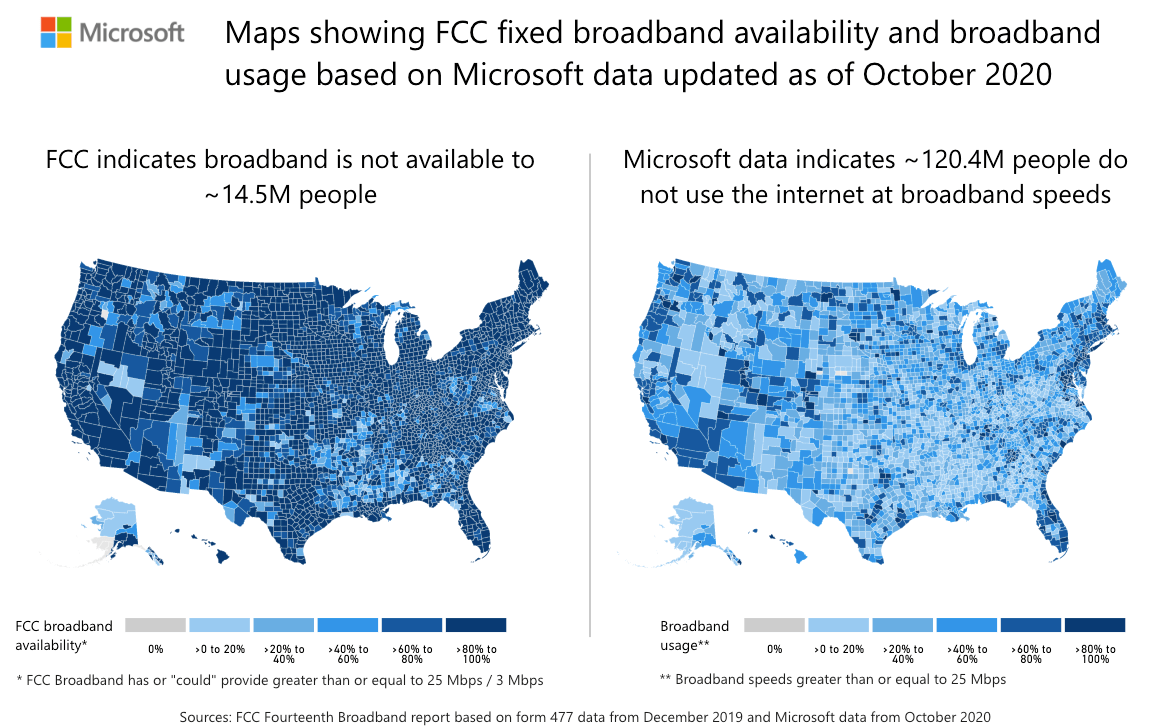We have an internet accessibility problem in this country, but it’s difficult to quantify how bad it really is.
According to Statista, “as of January 2024, there were approximately 331 million internet users in the United States,” and as of March 2024, almost 94% of the total population has accessed the internet at some point.
On the flip side, there were 27.8 million people in the U.S. who did not use the internet at the start of 2023, as cited by DataReportal.
There are many reasons for not using the internet, including that some people simply do not want or need to. Millions more living in the rural U.S. do want and need to access the internet but cannot due to lack of availability and/or affordability.
Getting minimum broadband speed
In March 2024, the Federal Communications Commission (FCC) increased the minimum broadband speed standard from 25/3 Mbps to 100/20 Mbps after nearly a decade. This change means that an internet connection cannot be considered high-speed “broadband” unless it consists of at least 100 Mbps of download speed and 20 Mbps of upload speed. In turn, this pushed internet providers to increase their respective speed tiers to reflect the new speed standard.
This new broadband definition also serves as a benchmark for measuring broadband access. The FCC reported that 45 million Americans lack access to 100/20 Mbps, making the distinction between having access to the internet in general and having access to suitable internet speeds. The broadband speed standard has also guided how state and federal broadband funding is dispersed throughout unserved and underserved areas.
Rural residents don’t have access to broadband
Wherever the numbers lie, they all tell the same story: Rural Americans don’t have the same access to broadband as those in urban areas. However, there has been some improvement in both availability and speed.
According to the NTCA – The Rural Broadband Association’s 2023 survey, consumers are adopting higher speed tiers once they become available. Almost 60% of the average consumer base subscribes to a speed greater than or equal to 100 Mbps, up from about 49% in 2022 and 37% in 2021.
The FCC’s 14th Broadband Report, released in 2021, found that “the number of Americans living in areas without access to at least 25/3 Mbps … has dropped from more than 18.1 million Americans at the end of 2018 to fewer than 14.5 million Americans at the end of 2019.”
While the speed standard has since increased, the FCC’s most recent Internet Access Services 2023 report analyzes the distribution of fixed connections, reporting that about 72 million (55%) of reported fixed connections in December 2023 had download speeds of at least 100 Mbps and less than 940 Mbps.
Why is there a lack of broadband access in rural areas?
Despite apparent growth in broadband access, there’s no denying that the unserved and underserved areas lacking broadband access are mainly located in rural parts of the country. This can be attributed to a few different factors:
Cost of building out broadband infrastructure
Broadband infrastructure is expensive to build out, especially in areas with small, dispersed populations. Internet service providers don’t want to invest in building out broadband, especially fiber, in these areas since their investment won’t be returned. Instead, ISPs focus on more densely populated areas with more people who can subscribe to their internet service.
Broadband data inaccuracies
Funding for broadband access relies on accurate reporting of those who have internet access across the country, and those who do not. The FCC’s broadband availability maps are known as the source of truth in revealing the unserved and underserved areas that need broadband funding.
In 2020, the FCC’s maps were revealed as grossly inaccurate in reporting broadband access when Microsoft released their own versions of the broadband availability maps. While the FCC reported 14.5 million were without access, Microsoft revealed this number to be over 120 million, and almost 160 million couldn’t even access 25/3 Mbps — the standard broadband speed at that time.
This meant that areas without broadband access or minimum broadband speeds were not being reported and, therefore, were not receiving funding.

Since then, the FCC launched the Broadband Data Collection (BDC) program. The program involves a new system of reporting broadband access throughout the country and new national broadband map data that consumers, states, Tribal governments and other stakeholders can challenge the accuracy of to ensure correct reporting. Once the new version of the broadband map was released in 2023, it was used to allocate funding.
Lack of internet access has devastating consequences
Though many Americans forgo broadband voluntarily, there’s no question that a lack of access is debilitating for the 4.5 million to 7.5 million households with no choice.
The digital divide and lack of access to high-speed internet came to the forefront during the 2020 pandemic, as students struggled across the country to adapt to online classes.
Around nine in 10 U.S. parents with K-12 children said their children had some online instruction since the pandemic began, according to a Pew Research online learning study.
Even before online classes became the norm, roughly 70% of teachers assign homework that requires internet access to complete, and 90% of high schoolers said they get assigned homework that has to be done online a few times a month, with almost half saying this happens daily.
It’s not just about completing homework assignments, though. One study saw test scores from students with limited internet access rise by 30% after they were given smartphones.
These disadvantages negatively impact our entire country, too. At least six independent studies have determined that broadband access has a direct positive impact on job creation, gross domestic product (GDP) growth and consumer surplus.
Microsoft wrote in its own analysis that “the counties with the highest unemployment also have the lowest broadband usage (and broadband access).”
What is being done to close the digital divide?
Although millions are still without broadband availability in the rural U.S., it’s important to remember that much progress has already been made in bridging the digital divide.
The government has acknowledged that addressing those remaining households with no broadband access will require tremendous private and public investment.
Federal funding
In 2021, the Bipartisan Infrastructure Law was passed, which delivers $65 billion in funding to build out broadband infrastructure in areas lacking access as part of the federal government’s Internet for All initiative. The Broadband Equity, Access and Deployment (BEAD) program has allocated over $42 billion of the funding in state broadband grants with the purpose of expanding high-speed internet access by funding planning, infrastructure, deployment and adoption programs in all 50 states and the U.S. territories.
The ReConnect Loan and Grant program also provides broadband funding in eligible rural areas. It has gone through five funding rounds and has allocated over $5 billion in funding so far.
Programs for broadband affordability
The Lifeline program provides $9.25/mo. off internet or mobile phone plans for qualified applicants.
Many organizations are working to improve broadband access as well. For example, Everyone On helps connect low-income families with affordable internet plans and devices in their area. Internet service providers have launched their own low-cost internet programs to help consumers with the cost of internet service. Explore programs from top providers like AT&T, Spectrum, Xfinity, Optimum, Verizon and more.
-
Featured
![What is the digital divide?]() What is the digital divide? Robin Layton — 5 min read
What is the digital divide? Robin Layton — 5 min read -
Featured
![ACP program allows eligible households to get high-speed internet for free]() ACP program allows eligible households to get high-speed internet for free Robin Layton — 2 min read
ACP program allows eligible households to get high-speed internet for free Robin Layton — 2 min read -
Featured
![Report: Internet users are gobbling data by more than a half-terabyte]() Report: Internet users are gobbling data by more than a half-terabyte Robin Layton — 4 min read
Report: Internet users are gobbling data by more than a half-terabyte Robin Layton — 4 min read
Latest
-
Friday, April 4, 2025
How to donate and safely recycle electronicsCamryn Smith — 8 min read
-
Thursday, April 3, 2025
Signs you’ve been hacked and how to prevent hackingRobin Layton — 4 min read
-
Wednesday, April 2, 2025
When will Google Fiber be available in your city?Camryn Smith — 5 min read









